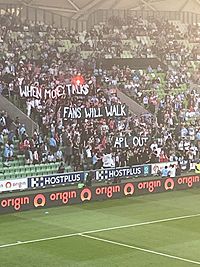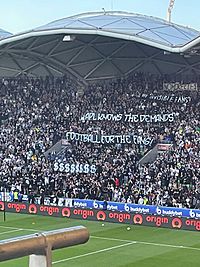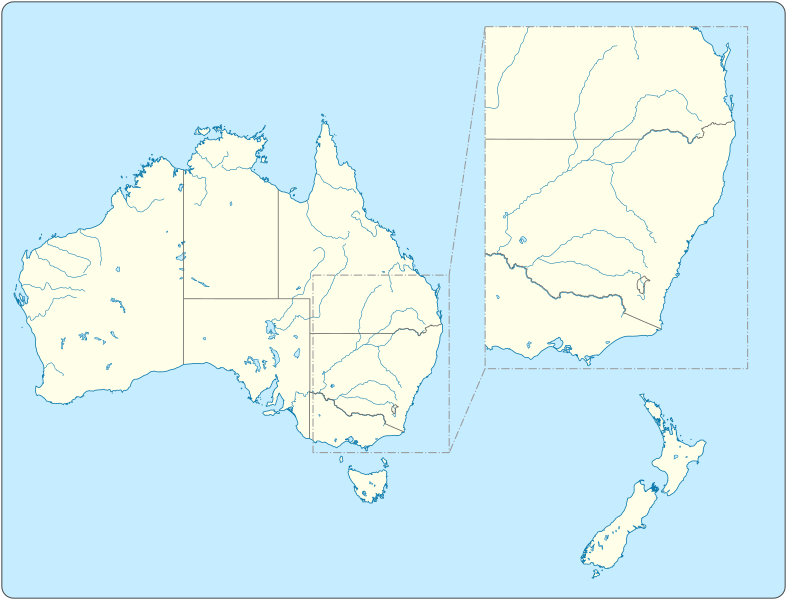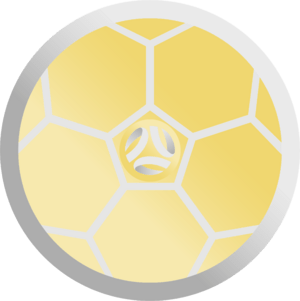A-League Men facts for kids
 |
|
| Organising body |
|
|---|---|
| Founded | April 2004 |
| First season | 2005–06 |
| Country | |
| Other club(s) from | |
| Confederation | AFC |
| Number of teams | 12 |
| Level on pyramid | 1 |
| Domestic cup(s) | Australia Cup |
| International cup(s) | |
| Current champions | Melbourne City (2nd title) (2024–25) |
| Current premiers | Auckland FC (1st title) (2024–25) |
| Most championships | Sydney FC (5 titles) |
| Most premierships | Sydney FC (4 titles) |
| Most appearances | Leigh Broxham (371) |
| Top goalscorer | Jamie Maclaren (152) |
| TV partners |
|
The A-League Men, also known as the Isuzu UTE A-League for sponsorship reasons, is the top professional soccer league in Australia and New Zealand. It was started in 2004 as the 'A-League' and games began in August 2005.
The league is managed by Australian Professional Leagues (APL). Twelve teams compete in the league: ten from Australia and two from New Zealand. The season runs from October to May. It includes a 27-round regular season, followed by a finals series (playoffs) with the top six teams. This all leads up to a big championship game called the grand final.
In the A-League, the team that finishes first in the regular season is called the 'Premier'. The team that wins the grand final is called the 'Champion'. This is a bit different from other sports in Australia.
The best teams in the A-League can qualify for big Asian club competitions like the AFC Champions League Elite and the AFC Champions League Two. In 2014, the Western Sydney Wanderers became the first and only Australian team to win the AFC Champions League.
Like some sports leagues in the United States, the A-League does not have relegation and promotion. This means teams don't move up or down to different leagues based on how well they play. The league also has a salary cap, which limits how much money teams can spend on player salaries.
Contents
History of the A-League
How the League Started
Before the A-League, Australia had a national soccer tournament called the National Soccer League (NSL). This league started in 1977 after Australia's national team played in the 1974 FIFA World Cup.
Over time, the NSL faced problems. Many Australian players went to play in leagues overseas, and the league struggled with TV deals and sponsors. Some clubs, like Sydney Olympic and Perth Glory, did well, but the league was slowly fading.
In 2003, the Australian government looked into how soccer was run in the country. A report found that the NSL wasn't making enough money to keep going. So, the new head of Australian soccer, Frank Lowy, decided to create a new national competition. The NSL ended after its 2003–04 season, after 27 years.
Building the A-League
The A-League was officially announced in April 2004. The plan was for eight teams to join the new league. There would be one team from each of the major cities: Sydney, Melbourne, Brisbane, Adelaide, Perth, and Newcastle. There would also be a team from New Zealand and one more from either Melbourne or Sydney. The first games were set to start in August 2005.
Many groups wanted to be part of the new league. By November 2004, the eight successful teams were chosen. The car company Hyundai Motor Company became the main sponsor, and the league was called the 'Hyundai A-League'.
The first eight teams were Adelaide United, the Central Coast Mariners, the Melbourne Victory, the Newcastle Jets, the New Zealand Knights, Perth Glory, the Queensland Roar, and Sydney FC. Some of these teams, like Adelaide United and Perth Glory, had played in the old NSL. Each club was given a special deal to be the only team in their city for five years. This helped them grow and build their own identity.
Early Seasons and Growth
The very first A-League season kicked off on August 26, 2005. Adelaide United won the Premier's Plate that season, but Sydney FC won the Grand Final by beating the Central Coast Mariners.
In the next season, Melbourne Victory won the Premier's Plate and then crushed Adelaide United 6–0 in the Grand Final. During this season, the New Zealand Knights team was replaced by the Wellington Phoenix. The Knights had struggled, winning only six games in 42 matches.
Over the years, more teams joined the league. Gold Coast United and the North Queensland Fury joined in 2009. Melbourne Heart (now Melbourne City) joined in 2010. However, North Queensland Fury and Gold Coast United later had their licenses removed due to financial problems.
In 2012, a new team from Western Sydney, the Western Sydney Wanderers, joined the league. In 2014, Melbourne Heart was bought by the City Football Group and became Melbourne City. The league continued to grow, adding Western United FC in 2019 and Macarthur FC in 2020.
In 2019, a big change happened. The clubs took over running the league from Football Federation Australia (FFA). This made the A-League similar to how many European soccer leagues are managed. The new group in charge is called the Australian Professional Leagues (APL).
How the A-League Works
Regular Season Games
The A-League regular season usually runs from early October to April. For the 2024–25 season, there are 29 rounds because there are now 12 teams. Each team plays 26 games in total, playing against every other team two or three times. Teams also have three 'byes' (weeks off).
When a team wins a match, they get three points. If it's a draw, both teams get one point. The team with the most points at the end of the regular season is crowned the A-League Premiers. They also get a special trophy called the Premier's Plate. The Premiers also get a spot in the AFC Champions League.
If two or more teams have the same number of points, there are rules to decide who ranks higher. These rules look at things like goal difference (goals scored minus goals against), total goals scored, and how many games they won.
Unite Round
For the 2023–24 and 2024–25 seasons, the A-League introduced "Unite Round." During this special weekend, all the A-League Men's and some A-League Women's matches are played in Sydney. This round is part of a deal with Destination NSW and was created after a decision to host all Grand Finals in Sydney was changed due to fan feedback.
Pride Round
In 2021, after Adelaide United player Josh Cavallo became the first openly gay top-level male soccer player, the A-League started a "Pride Round." This round celebrates and supports the LGBTQIA+ community.
The first official Pride Round for both men's and women's leagues happened in February 2023. A portion of ticket sales from these games went to Pride Cup, an organization that promotes inclusion. The A-Leagues continue to hold this round each year, offering training to players and using rainbow-themed items like corner flags and armbands to show support.
Finals Series and Grand Final
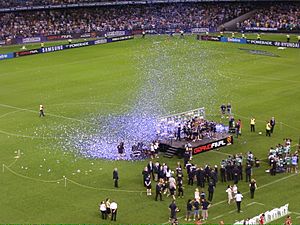
After the regular season, the top six teams play in a finals series. This series ends with the A-League grand final, where the winner is crowned the A-League Champion. The Champion receives the A-League Champions Trophy.
The finals series lasts four weeks. In the first week, teams ranked third through sixth play single-elimination matches. The two winners then join the first and second-ranked teams in two-game matchups over the next two weeks. The two winners of those matches then play in the grand final.
Before 2022, the team that finished higher in the regular season usually hosted the grand final. However, in December 2022, the APL announced that the grand finals for the 2022–23, 2023–24, and 2024–25 seasons would all be held in Sydney. This decision caused a lot of upset among fans. In October 2023, the APL changed its mind, and the Grand Final hosting rights went back to the original format, with the higher-ranked team hosting. The "Unite Round" was introduced instead.
Grand Final Host Stadiums
| Stadium | Location | No. hosted | Years hosted |
|---|---|---|---|
| Sydney Football Stadium | Sydney | 4 | 2006, 2008, 2013, 2017 |
| Melbourne Rectangular Stadium | Melbourne | 4 | 2015, 2021, 2022, 2025 |
| Docklands Stadium | 3 | 2007, 2009, 2010 | |
| Lang Park | Brisbane | 3 | 2011, 2012, 2014 |
| Western Sydney Stadium | Sydney | 2 | 2020, 2023 |
| Adelaide Oval | Adelaide | 1 | 2016 |
| Newcastle International Sports Centre | Newcastle | 1 | 2018 |
| Perth Stadium | Perth | 1 | 2019 |
| Central Coast Stadium | Gosford | 1 | 2024 |
Playing in Asian Competitions
AFC Champions League Elite
Australian A-League clubs can play in the AFC Champions League (now called AFC Champions League Elite) each season. However, the New Zealand teams, Wellington Phoenix and Auckland FC, cannot play in this Asian competition. They also don't play in the OFC Champions League (for Oceania teams).
Teams qualify for the AFC Champions League based on their league finish and if they win the Australia Cup. The only Australian team to win the Asian Champions League is Western Sydney Wanderers in 2014. Adelaide United also reached the final in 2008 but finished second.
AFC Champions League Two
Australian clubs also started playing in the AFC Cup (now called AFC Champions League Two) in the 2023–24 season. The Central Coast Mariners won this competition in their first try.
Other Competitions and Youth Leagues
In 2004–05, before Australia joined the Asian football group, Sydney FC won the right to play in the OFC Champions League (Oceania Club Championship).
Since 2014, A-League clubs also compete in the yearly Australia Cup, which is a knockout tournament.
Most A-League Men clubs have teams in the A-League Youth competition. This league helps young players (aged 16-21) develop their skills. There is also the A-League Women competition, which is the top women's soccer league in Australia and is connected to the men's league.
A-League Clubs
Currently, 12 teams play in the A-League: ten from Australia and two from New Zealand. In total, 16 different teams have played in the league since it started. Only four of the current clubs existed before the A-League began in 2004: Adelaide United, the Brisbane Roar, the Newcastle Jets, and the Perth Glory.
Unlike most soccer leagues around the world, the A-League does not have a system where teams move up or down divisions (no relegation and promotion). This is similar to how many professional sports leagues work in Australia and North America.
| Current Clubs | |||||||||
|---|---|---|---|---|---|---|---|---|---|
| Team | City | State | Stadium | Capacity | Founded | Joined | Head coach | Team captain | |
| Adelaide United | Adelaide | South Australia | Coopers Stadium | 16,500 | 2003 | 2005 | |||
| Auckland FC | Auckland | Auckland | Go Media Stadium | 25,000 | 2023 | 2024 | |||
| Brisbane Roar | Brisbane | Queensland | Suncorp Stadium | 52,500 | 1957 | 2005 | |||
| Central Coast Mariners | Gosford | New South Wales | Industree Group Stadium | 20,059 | 2004 | 2005 | |||
| Macarthur FC | Campbelltown | New South Wales | Campbelltown Sports Stadium | 17,500 | 2017 | 2020 | |||
| Melbourne City | Melbourne | Victoria | AAMI Park | 30,050 | 2009 | 2010 | |||
| Melbourne Victory | 2004 | 2005 | |||||||
| Newcastle Jets | Newcastle | New South Wales | McDonald Jones Stadium | 30,000 | 2000 | 2005 | |||
| Perth Glory | Perth | Western Australia | HBF Park | 20,500 | 1995 | 2005 | |||
| Sydney FC | Sydney | New South Wales | Allianz Stadium | 42,500 | 2004 | 2005 | |||
| Wellington Phoenix | Wellington | Wellington | Sky Stadium | 34,500 | 2007 | 2007 | |||
| Western Sydney Wanderers | Sydney | New South Wales | CommBank Stadium | 30,000 | 2012 | 2012 | |||
| Future Clubs | ||||||||
|---|---|---|---|---|---|---|---|---|
| Team | City | State | Stadium | Capacity | Founded | Joined | ||
| Unnamed Canberra club | Canberra | Australian Capital Territory | TBC | TBC | TBC | TBC | ||
| Former Clubs | ||||||||
|---|---|---|---|---|---|---|---|---|
| Team | City | State | Stadium | Capacity | Founded | Joined | Exited | |
| Gold Coast United | Gold Coast | Queensland | Skilled Park | 27,690 | 2008 | 2009 | 2012 | |
| New Zealand Knights | Auckland | Auckland | North Harbour Stadium | 22,000 | 1998 | 2005 | 2007 | |
| North Queensland Fury | Townsville | Queensland | Dairy Farmers Stadium | 26,500 | 2008 | 2009 | 2011 | |
| Western United | Wyndham | Victoria | Ironbark Fields | 5,000 | 2017 | 2019 | 2025 | |
Team Timeline
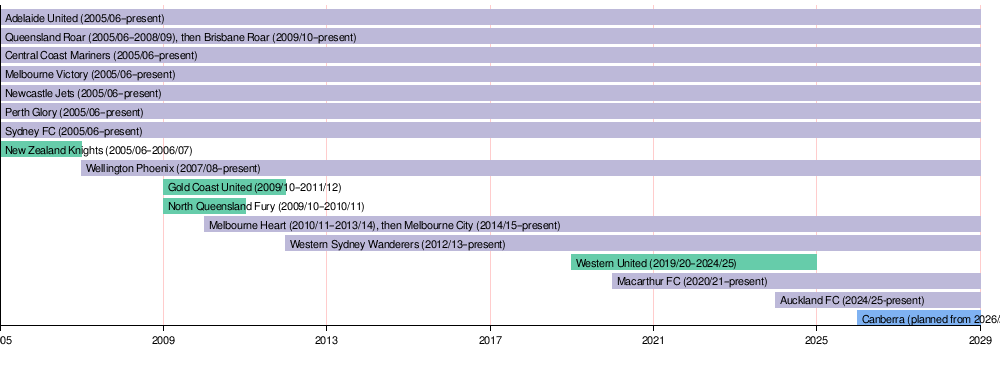
League member Former member Future member
League Expansion
The A-League started with eight teams, but there was always interest in adding more. The first eight clubs had a special agreement that no other teams could join from their cities for five years. However, new teams could join from other areas.
In February 2018, officials announced that the league would grow to 12 teams for the 2019–20 season. In December 2018, Western United FC was accepted and joined in 2019–20. Macarthur FC joined the league the following season (2020–21).
In March 2023, the Australian Professional Leagues confirmed plans for two more new clubs. These clubs would be based in Canberra, Australia, and Auckland, New Zealand, and were planned to join for the 2024–25 season.
In October 2023, it was confirmed that businessman Bill Foley would own the new Auckland team. The team, named Auckland FC, officially joined the league for the 2024–25 season.
However, the new Canberra men's team did not start in the 2024–25 season. Its entry was delayed, and it is now expected to join later.
Team Rivalries
The A-League has several exciting rivalries between teams, often called "derbies." These matches are usually very intense and draw large crowds.
- "Melbourne Derby" – Melbourne City vs Melbourne Victory
These two Melbourne teams first played each other in 2010. Melbourne City (then called Melbourne Heart) won 2–1. Melbourne Victory had been in the league longer and was more successful, which added to the rivalry. These games are known for their great atmosphere and large attendance.
- "The Original Rivalry" – Adelaide United vs Melbourne Victory
This rivalry comes from the long-standing competition between sports teams from South Australia and Victoria. It became even stronger after some heated moments in the 2006–07 season. These two teams played in the 2007 and 2009 Grand Finals, with Melbourne winning both.
- "Sydney Derby" – Sydney FC vs Western Sydney Wanderers
This derby started in the 2012–13 season when the Western Sydney Wanderers joined the league. The first derby was won by Sydney FC. A Sydney Derby in 2015 broke the attendance record for a regular season game at Allianz Stadium. In 2016, a match between these two teams set a new A-League crowd record with 61,880 fans. The rivalry is strong because the teams are from different parts of Sydney.
- "The Big Blue" – Melbourne Victory vs Sydney FC
This match is called "The Big Blue" because both teams wear blue, and "Big Blue" is Australian slang for a big contest. This rivalry has grown due to many intense games and the long-standing competition between Australia's two largest cities, Sydney and Melbourne. They have played each other in three Grand Finals. A "Big Blue" match is often played on Australia Day each year.
- "The F3 Derby" – Central Coast Mariners vs Newcastle Jets
This derby is named after the freeway that connects Newcastle and Gosford, where these two clubs are based. They are the only two A-League clubs not located in state or national capital cities. Their stadiums are only an hour apart. The rivalry became more intense when they competed for the premiership in 2007–08 and then met in the Grand Final, which the Jets won. Since 2022, the teams compete for a special trophy made from a sample of the motorway.
- "The Distance Derby" – Perth Glory vs Wellington Phoenix
This game is considered one of the longest away trips in professional soccer because of the huge distance (5,225 km) between Perth, Australia, and Wellington, New Zealand. Since 2015–16, the teams play for the "Long Distance Derby Cup," which goes to the team with the best results from their regular season games.
- "New Zealand Derby" / "Mai te Raki ki te Tonga" – Auckland FC vs Wellington Phoenix
With the new Auckland FC team joining in the 2024–25 season, Wellington now has another team from New Zealand to play against. The first game between them was on November 2, 2024. The official name for this derby is "Kiwi Clasico," but it is also known as "Mai te Raki ki te Tonga," which means 'From the North to the South' in the Māori language.
League Organization
Logo and Branding
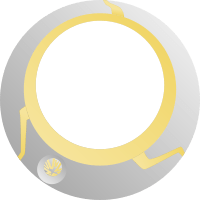
The current A-League logo was revealed in September 2021. It was part of a bigger change to bring the A-League Men and A-League Women under one "A-Leagues" brand. Isuzu UTE became the main sponsor of the A-League Men in October 2021, so their name is on all the branding. This partnership was extended in December 2023.
The original A-League logo, used from 2004 to 2017, had two colors that represented the sun, earth, and desert. The eight 'A' shapes in the logo stood for the eight founding clubs.
Trophies
The A-League has two main trophies: the Premier's Plate and the A-League Trophy. The Premier's Plate is given to the team that finishes first in the regular season. The A-League Trophy is given to the team that wins the Grand Final.
Both trophies were designed by a company called D3 Design. The A-League Trophy is sometimes jokingly called the "Toilet Seat" because of its shape. When the A-League Trophy was first shown in 2005, the CEO of Football Federation Australia said they wanted a new trophy that looked modern and different. The designers said the trophy was inspired by the laurel wreath given to winners in the ancient Olympic Games.
Team Rules and Salary Cap
An A-League team can have a minimum of 20 players and a maximum of 26. On game day, 11 players start, and five substitutes can be used.
Teams can have a maximum of five "foreign" players (from outside Australia or New Zealand). Three players in the squad must be under 20 years old. Clubs can also sign three more young players (under 20) on special lower-paid contracts.
The A-League has a salary cap, which is a limit on how much money a team can spend on player salaries. However, teams are allowed to have two "marquee" players whose salaries do not count towards the cap. These are usually famous or high-profile players. Teams can also have "guest players" for up to 14 games, and their salaries don't count either.
Since 2008–09, clubs have been allowed a "junior marquee" player (under 23). This is now called the 'Homegrown Player allowance'. Clubs can spend up to $150,000 on three Australian players aged 23 or younger who came from the club's youth system.
In 2010, clubs were also allowed an "Australian marquee" player whose salary didn't count towards the cap. Famous marquee players have included Alessandro Del Piero, Keisuke Honda, and David Villa. Well-known Australian marquees include Harry Kewell and Tim Cahill.
From the 2021–22 season, the league added a "designated player" slot, whose salary is also exempt from the cap, but must be between $300,000 and $600,000 per season. The next season, a second designated player slot was added.
Players who have played for their club for 5–10 years can have part of their salary exempted from the cap as a "loyalty player allowance."
The salary cap for A-League clubs for the 2020–21 season was $2.1 million. New clubs could have a slightly higher cap. Clubs must spend at least $1.7 million on player salaries.
| Season | Marquee player | Australian marquee | Junior marquee | Designated player | Mature-aged rookie | Salary cap | Minimum salary |
|---|---|---|---|---|---|---|---|
| 2005–06 | 1 | No | No | No | No | $1,500,000 | |
| 2006–07 | 1 | No | No | No | No | $1,600,000 | |
| 2007–08 | 1 | No | No | No | No | $1,800,000 | |
| 2008–09 | 1 | No | 1 | No | No | $1,900,000 | |
| 2009–10 | 1 | No | 1 | No | No | $2,250,000 | |
| 2010–11 | 1 | 1 | 1 | No | No | $2,350,000 | |
| 2011–12 | 1 | 1 | 1 | No | No | $2,400,000 | |
| 2012–13 | 1 | 1 | 1 | No | No | $2,468,000 | $48,000 |
| 2013–14 | 1 | 1 | 1 | No | No | $2,500,000 | $50,000 |
| 2014–15 | 1 | 1 | 1 | No | No | $2,550,000 | $51,000 |
| 2015–16 | 2 | 1 | No | 1 | $2,600,000 | $55,000 | |
| 2016–17 | 3 | 1 | No | 1 | $2,650,000 | $55,715 | |
| 2017–18 | 2 | 1 | No | 1 | $2,928,000 | $61,287 | |
| 2018–19 | 2 | 1 | No | 1 | $3,063,000 | $64,113 | |
| 2019–20 | 2 | 1 | No | No | $3,200,000 | $47,792–$64,113 | |
| 2020–21 | 2 | 1 | No | No | $2,100,000 | $45,000–$62,500 | |
| 2021–22 | 2 | 1 | 1 | No | |||
| 2022–23 | 2 | 1 | 2 | No | |||
Stadiums Where Games Are Played
A-League games have been played in 33 different stadiums since the league started in 2005.
Sponsorship Deals
Since it began, the A-League has had a main sponsor. From 2004 to 2020, Hyundai Motor Company was the sponsor, and the league was known as the "Hyundai A-League."
On October 6, 2021, Isuzu UTE became the new main sponsor for three years. The league is now called the Isuzu UTE A-League. This sponsorship deal was extended for another two years in December 2023.
| Period | Sponsor | Name |
|---|---|---|
| 2005/06–2019/20 | Hyundai | Hyundai A-League |
| 2020/21 | No title sponsor | A-League |
| 2021/22–Present | Isuzu UTE | Isuzu UTE A-League |
League Championships
As of the 2024–25 season, 16 different clubs have played in the A-League. Eight of these clubs have won the A-League Trophy (Champions), and nine have won at least one Premier's Plate (Premiers). Six clubs have won both the Premiership and Championship in the same season, which is called a 'Double'. This has happened 11 times in total.
Remember, the 'Premier' is the winner of the regular season, and the 'Champion' is the winner of the Grand Final.
| Team | Champions | Year(s) won | Premiers | Year(s) won | Total combined | 'Double' | A-League seasons |
|---|---|---|---|---|---|---|---|
| Sydney FC | 5 | 2006, 2010, 2017, 2019, 2020 | 4 | 2009–10, 2016–17, 2017–18, 2019–20 | 9 | 3 (2010, 2017, 2020) | 20 |
| Melbourne Victory | 4 | 2007, 2009, 2015, 2018 | 3 | 2006–07, 2008–09, 2014–15 | 7 | 3 (2007, 2009, 2015) | 20 |
| Central Coast Mariners | 3 | 2013, 2023, 2024 | 3 | 2007–08, 2011–12, 2023–24 | 6 | 1 (2024) | 20 |
| Brisbane Roar | 3 | 2011, 2012, 2014 | 2 | 2010–11, 2013–14 | 5 | 2 (2011, 2014) | 20 |
| Melbourne City | 2 | 2021, 2025 | 3 | 2020–21, 2021–22, 2022–23 | 5 | 1 (2021) | 15 |
| Adelaide United | 1 | 2016 | 2 | 2005–06, 2015–16 | 3 | 1 (2016) | 20 |
| Newcastle Jets | 1 | 2008 | 0 | – | 1 | 20 | |
| Western United | 1 | 2022 | 0 | – | 1 | 6 | |
| Western Sydney Wanderers | 0 | – | 1 | 2012–13 | 1 | 13 | |
| Perth Glory | 0 | – | 1 | 2018–19 | 1 | 20 | |
| Auckland FC | 0 | – | 1 | 2024–25 | 1 | 1 | |
| Macarthur FC | 0 | – | 0 | – | 0 | 5 | |
| Wellington Phoenix | 0 | – | 0 | – | 0 | 18 |
League Records
Brisbane Roar holds the record for the longest unbeaten streak in the A-League, going 36 matches without a loss.
Jamie Maclaren is the top goalscorer in A-League history, with 151 goals for three different clubs. He also holds the record for the most A-League hat-tricks (scoring three goals in one game) with 8.
The record for most goals in a single match is 5 goals. This was achieved by Archie Thompson in 2007 and by Jamie Maclaren in 2021.
Shane Smeltz and Bobô are the only players to score hat-tricks in two games in a row.
In 2015, Austrian player Marc Janko set a record by scoring in seven consecutive matches for Sydney FC.
Media Coverage
Watching Games in Australia
From 2005 to 2013, A-League games in Australia were only shown on the subscription channel Fox Sports.
In 2012, the free-to-air TV network Special Broadcasting Service (SBS) also started showing A-League games alongside Fox Sports.
SBS stopped broadcasting in 2017, and Network Ten took over the free-to-air rights. They showed one Saturday night game on their digital channel, One.
From 2019, ABC TV broadcast one live game each weekend.
Since August 2021, as part of a five-year deal, A-League games are broadcast by Network 10 and the Paramount+ streaming service. One A-League Men's match is shown on Network 10's main channel each weekend, and all matches are streamed on Paramount+. These broadcasting rights continue until 2028.
| Seasons | Pay | FTA |
|---|---|---|
| 2005–13 | Fox Sports | None |
| 2013–17 | SBS | |
| 2017–19 | Network 10 | |
| 2019–21 | ABC | |
| 2021–26 | Paramount+ | Network 10 |
Watching Games in Other Countries
In New Zealand, the A-League has been shown on Sky Sport since its first season.
The A-League is also broadcast in many other countries around the world. In 2013–14, games were shown in 65 countries. Full matches are available in places like the United States, China, Italy, England, and Canada. Highlights are shown in many Asian and Middle Eastern countries.
All A-League matches are also streamed live online globally through a subscription service.
Promoting the League
The A-League has used different slogans and advertising campaigns to promote itself. For the first season, a big advertising campaign was launched with the slogan: "Football, but not as you know it." Later campaigns included "90 minutes, 90 emotions."
Current Broadcasters (2024–25 Season)
Images for kids
See also
 In Spanish: A-League para niños
In Spanish: A-League para niños


